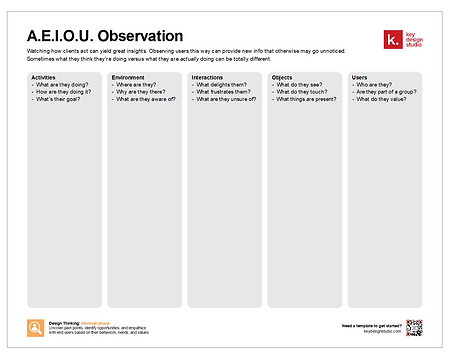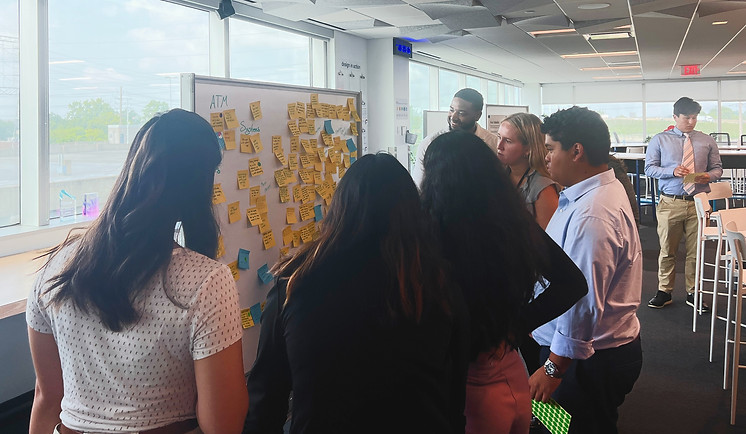KeyBank
Corporate Center Design Thinking Workshop
How might we teach interns about the fundamentals of design thinking through a fun, interactive workshop?

Team
Eva Regelski Jenny Taylor
Role
Lead Facilitator
Participants
12 interns
Project Brief
Stakeholders in the corporate center asked us to lead a half-day workshop for the corporate center interns about the fundamentals of design thinking. We started the experience a week before the actual workshop with a virtual meeting to go over the basics of the Discovery phase in the design thinking process and gave them two discovery tools they would be using to complete their research in their assigned branches. We also gave them their problem statement they would all be working on:
Problem Statement
How might we provide a better client experience both in-branch and via the drive-thru window when a client visits with a simple teller transaction?
After giving the interns the problem statement they'd be working with, we gave them branch assignments and scheduled them time to interview branch managers as well as conduct some client observations.
Agenda
In-person workshop

Objectives:
-
Review the design thinking process
-
Analyze the interns discovery work
-
Identify pain points
-
Ideate potential solutions
-
Plan next steps
Welcome & Intros
With everyone sitting in a large circle, I welcomed interns and had everyone give brief introductions on who they are, what they’re studying, any relevant experience + something that people might not know about them.
Next, I walked through the agenda for the day.
Sketching - Warm Up
Introduced warm up activity: “To set the stage for the day, we’re going to be doing a fun little warm up activity. The purpose of this exercise is not to be perfect, but just to warm up and get our brains thinking.”
-
Set the timer for 3 minutes and instruct everyone to draw out each step in the process of making toast.
-
At the end of the 3 minutes, have everyone compare their drawings. This is a learning moment for them and a way to open their minds because everyone has a different process and a different interpretation of making toast, but they are all correct!
Materials: Drawing paper, markers, pencils, pens

Present Discovery Work
Gave each intern a few minutes to informally present their biggest takeaways from their branch visits.
The interns conducted contextual interviews with branch managers as well as A.E.I.O.U observation of clients inside the branch and in the drive-thru experience.



Affinity Mapping
Introduced activity: "Affinity mapping is useful for when you have a lot of data you need to condense into understandable themes. This will help us make sense of your user interviews."
-
Have interns take a few minutes to individually write down each piece of useful information on sticky notes. Make sure there is no more than 1 idea on each sticky note.
-
Once this is done, have the interns group like post it notes together
-
Then have them go through and name each group based on the theme that connects them.
-
Have every intern share out the groups that they made and what area they want to focus on for this project.
-
Have interns vote for their top 3 post-it notes to help identify the biggest pain points they observed
Materials: Big paper, post its, sharpies

Journey Mapping
Introduced the activity: "Journey maps are helpful for when there is a multi-step process or experience you want to understand better. This is what we will be using to make sense of the drive through and in-branch experiences."
-
Create 2 journey maps as a group, one for the in-branch experience, and one for the drive-through experience.
-
Have interns share what they think the biggest pain points are and where they think we should focus for ideation.
Materials: Big paper or whiteboard, post its, sharpies or expo markers
In-Branch Journey Map

Drive-Thru Journey Map

Pain Points
From journey maps and affinity map


Ideation
Introduced activity: "Now that we’ve identified major pain points, we’re going to take some time to ideate solutions using the 6-to-1 ideation method as a group."
"When we ideate, it’s really important to separate out idea generation from idea evaluation. So, for this activity, let’s just focus on generating ideas– we’ll evaluate them later."
Have interns write down as many ideas as they can on post it notes for each of the 6 buckets. We will go through them as a group after.
Materials: large 6-to-1 ideation paper, stacks of post its, sharpies

Idea Prioritization
Introduced activity: "We’ve just generated a lot of ideas. Now we’ll take some time to evaluate some of our favorites."
-
Everyone walks around and votes for their 2 favorite ideas using dots. (5 minutes)
-
Pull off the top 3 most voted for ideas
-
Discuss favorite ideas, why they might work, why they might not work, who needs to be involved for an idea to work, who should be held accountable.
-
Take notes during discussion.
Materials: dots, idea board

Wrap Up & Next Steps
Recapped the day and where we ended up. Ask interns to write down next steps (what they would do if they had more time to work on this project and go through the rest of the design process).
Have everyone share out their next steps.
Post-Workshop Survey
In order to assess how the workshop went, I sent out a short survey to the interns the day after the workshop.
Survey Results
1. How would you rate each of the following items of the workshop?

2. What did you enjoy most about the workshop?
"I enjoyed the affinity/journey mapping portion the most. I found this exercise to be extremely helpful in identifying the high and low points of a client interaction and capturing the feelings of them at the various stages."
"I liked all the team work that took place on Thursday and hearing everyone's different ideas."
"I enjoyed the ideation phase the most. It was really fun brainstorming and finding creative solutions to real issues."
"I really liked hearing about the other interns experiences at their branch and noticing how their experience might've differed from mine!"
"I liked being able to experience the creative process from start to nearly finish (without implementation). It is also nice to think autonomously. I feel like I dont get to freely think, I am often told how I should do things, rather than being able to come up with my own solutions for problems."
3. Do you feel that you received value from attending the workshop?

4. Do you feel that you made a valuable contribution to the workshop?

5. Is there anything that surprised you about the workshop?
"I was surprised by how interactive it all was. I really enjoyed how engaging the workshop was!"
"It was a good experience!"
"I think what surprised me the most was how vastly different each intern's experience was from branch to branch, with a few similarities here and there."
"How nice the Idea Lab in Tiedeman is!"
"Not really!"